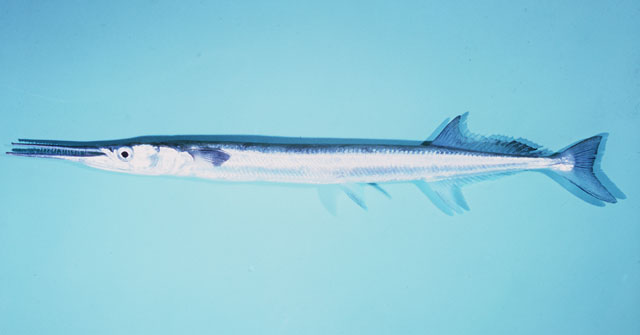| Belonidae (Needlefishes) |
| 153 cm TL (male/unsexed); max.weight: 3,710.0 g |
|
reef-associated; marine; depth range - 0 m |
| Western Atlantic: Massachusetts, USA to Brazil. Eastern Atlantic: off Morocco and the Mediterranean (Ref. 5505). |
|
Dorsal spines (total): 0-0; Dorsal soft rays (total): 20-27; Anal spines: 0-0; Anal soft rays: 20-24; Vertebrae: 90-95. Diagnosis: body elongate; upper and lower jaws extremely long, forming a stout beak armed with very sharp teeth; gill rakers absent (Ref. 57228, 90102). Nostrils in depression before eyes (nasal pit); pelvic fins abdominal; 20-26 dorsal-fin rays; anal fin short, 9.7-11.7 times in body length; small, black lateral keel on either sides of caudal peduncle; caudal fin deeply forked (Ref. 57228).
Description: body less rounded in cross-section than T. crocodilus (Ref. 57228). Upper jaw nearly even with lower jaw (Ref. 90102). Anterior rays of dorsal and anal fins forming relatively high lobes that are comprised from 10.5-13.3 and from 9.7-11.7 times, respectively, in body length (Ref. 57228, 90102). Dorsal fin origin about equal with or slightly anterior to origin of anal fin (Ref. 90102). Pectoral and pelvic fins rather short, comprised from 8.0-12.4 and from 10.0-14.1 times, respectively, in body length (Ref. 57228). Lower lobe of caudal fin longer than upper (Ref. 57228, 90102). 267-430 (Ref. 57228) or 280-340 (Ref. 90102) predorsal scales. Left gonad absent or strongly reduced in both sexes (Ref. 57228).
Coloration: back dark blue, belly silvery white; blue line along sides (Ref. 57228). Dorsal fin in juveniles with elevated posterior lobe which disappears with growth (Ref. 57228). Blackish margin on caudal fin (Ref. 90102). |
| Inhabits oceanic and neritic waters (Ref. 26340). Feeds on small fishes. Oviparous (Ref. 205). Eggs may be found attached to objects in the water by tendrils on the egg's surface (Ref. 205). Although sold fresh and salted, its market is limited due to the green-colored flesh (Ref. 5217). Circumglobal in tropical seas and divisible into four subspecies (Ref 90102). |
|
Least Concern (LC); Date assessed: 10 July 2012 Ref. (130435)
|
| traumatogenic |
|
Fished almost throughout the year. Considered a third rate food fish. Also Ref. 3129. |
Source and more info: www.fishbase.org. For personal, classroom, and other internal use only. Not for publication.

